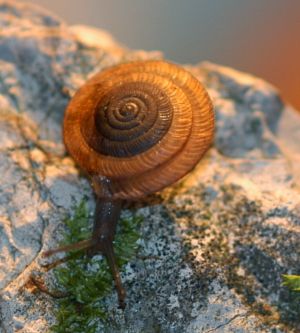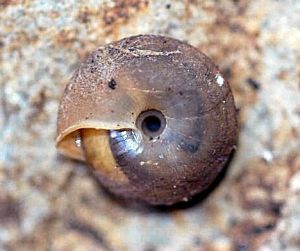|
The University of Wales, Cardiff and The Gibraltar Museum, Gibraltar The genus Oestophora Hesse, 1907 is represented in Iberia by seven species: O. barbula (Rossmässler, 1838), O. dorotheae Hesse, 1930, O. lusitanica (Pfeiffer, 1841), O. ortizi De Winter and Ripken, 1991, O. silvae Ortiz de Zárate, 1962, O. tarnieri (Morelet, 1854) and O. calpeana (Morelet, 1854) (Puente, 1994). Of these O. barbula has the widest distribution (mostly western Iberia) followed by O. lusitanica (north and central western Iberia) and O. silvae (northern Iberia); the others are restricted to southern Iberia. O. calpeana is known in Iberia only from Gibraltar, its type locality. In 1953 Morelet described this species as Helix lenticularis B Minor from material collected in Gibraltar by Tarnier. He named it a year later as Helix calpeana (Ortiz de Zárate, 1962), after Calpe, an old name for Gibraltar, thought to derive from the Phoenician kalph, which means to hollow out (Hills, 1974). I have sampled a large number of sites in southern Iberia, as has Arr_bola (1995) and have never found the species other than in Gibraltar. This extremely narrow distribution led Arr_bola to think it may have been introduced, although fossil material from Gibraltar suggests this is not the case. Ortiz de Zárate (1962) knew the species only from Gibraltar and wrote (p90): ‘Como localidad de la especie sólo conozco la citada por el autor, Gibraltar, al pie de las fortificaciones sobre el punto culminante del promontorio’; although there are records from Tangier and Ceuta in North Africa (Puente, 1994). Both Kobelt (1883) and Norris (1976) found the species in surveys of Gibraltar. O. calpeana can be found under rocks, logs and other types of shelter in habitats that range from steppe and garigue to maquis and woodland, principally in areas of the Upper Rock, Europa Point, Windmill Hill Flats and the Mediterranean Steps (Menez, 1993). It is never abundant and where it occurs typical densities in plots of 20x20m are 0.1-1m2. I have sometimes found clusters of 5-10 individuals under the same rock, or log, but this is uncommon. It has a shell height of about 5.0mm (exceptionally to 6.0mm) and a diameter of about 11.5mm (exceptionally over 15mm). Gibraltar is quite remarkable for land molluscs and in an area of about 6 km2 there are 42 species. There are two other Oestophora species that occur here: O. barbula and O. tarnieri, but, because of its restricted range and name, I like to think of O. calpeana as the Gibraltarian snail! We are lucky in Gibraltar in having robust laws that protect wildlife and O. calpeana is afforded special protection (along with other species) in Schedule 3 of the Nature Protection Ordinance, 1991 (Menez, 2005). After my fieldwork session at the weekend (carrying out distribution and diversity studies of land molluscs) it occurred to me that very few people have seen the Gibraltarian snail. And so the main goal of this short article is to show people what it looks like and give a little information about it.
|
Fig 1 & 2 The Gibraltarian snail, Oestophora calpeana (Morelet, 1854), has a restricted range and in Iberia is only found in Gibraltar (its locus typicus) where it is afforded special protection in Schedule 3 of the Nature Protection Ordinance, 1991. It has also been recorded from Tangier and Ceuta in North Africa. (Photos: Alex Menez) |
Oestophora calpeana (Morelet, 1854): The Gibraltarian snail
Issue
10
Page
9


